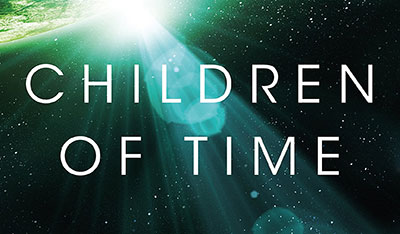On the Origin of Portiids

To celebrate the release of Adrian Tchaikovsky’s SF epic Children of Time, the author has kindly agreed to put some words together in an altogether pleasing arrangement.
Children of Time and Speculative Evolution By Adrian Tchaikovsky
It began with a man named Dougal Dixon.
Probably it began before then, but Dixon was my first introduction to the games you can play with evolution, which led eventually, through twists and turns, to Children of Time.
Children of Time’s premise is that an uplift experiment set up by a human scientist ends up being abandoned (due to a little matter of the end of human civilization as we know it), with the result that the uplift mechanism (mostly in the form of an engineered nanovirus) finds a wholly unexpected beneficiary amongst the local wildlife. By the time the experimenter’s distant descendants reach the planet – looking for a new home – something new and strange and unwelcome has force-evolved, developed a society and a technology, and is more than ready to contest ownership.
The evolution in Children is perforce somewhat artificial, owing to the virus’s ministrations. It happens quickly, and although the virus’s intent is somewhat thwarted by the unforeseen biology of its hosts, there is still something of a guiding hand in the background. The end result, the “Portiids”, is still something that I think could conceivably evolve, over a much longer period, given the chance, and the civilization the creatures build develops organically, each period we see arising out of the achievements and the failures of the last. Even though there is a certain mirroring of our own history at times. After all I am, to my regret, only human.
Dougal Dixon wrote a book called After Man, detailing an imaginary evolution of Earth’s surviving animals after the extinction of humanity – a world mostly populated by rat- and rabbit-ancestor creatures radiating out to fill ecological niches left vacant by the megafauna that predeceased us. It is, frankly, a work of genius, and Dixon followed it up with several other volumes exploring tangents on the same theme, and was later involved in the TV series The Future Is Wild which took the same premise but with very different players and results. That, in fact, is speculative evolution in a nutshell – a general rejection of predestination. If you ran the great experiment of life on Earth again, there’s no guarantee you’d get humans again, or anything humanoid, or even mammals of any kind.
Other minds have applied the same logic to alien evolution – the basic premise of evolution itself is very robust; the logic should work no matter what building blocks, so long as you have some sort of generational replication mechanism prone to occasional errors (for us, mutations in our DNA) and some manner of competition (limited resources) to allow advantageous variants to multiply faster. Hence, it’s entirely possible to speculate what might evolve on alien worlds, such as the planet Snaiad (the artist Memo Kosemen), Furaha (Nastrazzurro) or the excellent exploration of the idea Evolving the Alien by Cohen and Stewart, the same scientists who assisted Anne McCaffrey with the science of Pern, and who later went on to write the Science of the Discworld series with Sir Terry Pratchett.
Non-human societies is usually more of a giant leap than speculative evolution likes to take, but it forms the backbone of the Portiid plot in Children of Time. As the human crew of the ark ship live their punctuated lives, in and out of suspension as new disasters arise, the Portiids are developing awareness, inventing a very unfamiliar technology, speculating about the universe, and how they came to be. They face a lot of the same difficulties as we humans have: predators, war, plague, ideological conflicts, but they solve each crisis with their very different toolkit. Where that toolkit leads them, and what happens when their makers return for them, is the heart of their story.
News Archives
- August 2024
- July 2023
- April 2023
- February 2023
- September 2022
- March 2022
- February 2022
- July 2021
- June 2021
- April 2021
- March 2021
- January 2021
- October 2020
- September 2020
- June 2020
- March 2020
- May 2019
- January 2019
- November 2018
- January 2016
- September 2015
- August 2015
- July 2015
- June 2015
- May 2015
- April 2015
- March 2015
- January 2015
- October 2014
- June 2014
- April 2014
- March 2014
- February 2014
- January 2014
- December 2013
- November 2013
- October 2013
- September 2013
- June 2013
- May 2013
- April 2013
- March 2013
- January 2013
- December 2012
- November 2012
- August 2012
- July 2012
- June 2012
- May 2012
- April 2012
- March 2012
- February 2012
- January 2012
- December 2011
- November 2011
- October 2011
- September 2011
- August 2011
- July 2011
- June 2011
- May 2011
- April 2011
- March 2011
- February 2011
- January 2011
- December 2010
- November 2010
- October 2010
- September 2010
- August 2010
- July 2010
- June 2010
- May 2010
- April 2010
- March 2010
- February 2010
- January 2010
- December 2009
- November 2009
- October 2009
- September 2009
- August 2009
- July 2009
- June 2009
- May 2009
- April 2009
- March 2009
- February 2009
- January 2009
- December 2008
- November 2008
- October 2008
- September 2008
